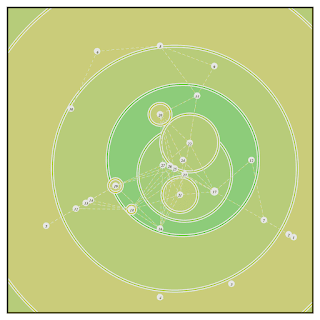Creative coding artwork with the Fibonacci number.
Meaningless shapes with the Fibonacci number.
It's a creative coding artwork made with the 'Processing'. It draws beautiful but meaningless shapes with the Fibonacci number.
I wanted to make some meaningless image that looks like something meaningful at a glance. I used the Fibonacci number and translate these to rotational coordinates to draw some shapes.
The 'Processing' example code.
This code does not display any images on the screen but generates image files in frames directory.
Please feel free to use this example code under the terms of the GPL.
To see other works based on my code is my pleasure. And my honor.
/**
* Invisible Connections.
* draw some meaningless shapes with Fibonacci number.
*
* Processing 3.5.3
* @author @deconbatch
* @version 0.1
* created 0.1 2020.03.29
*/
void setup() {
size(980, 980);
colorMode(HSB, 360, 100, 100, 100);
rectMode(CENTER);
textAlign(CENTER, CENTER);
smooth();
}
void draw() {
int frmMax = 3; // draw three images
int seqMax = 28;
int fibMin = 0;
int fibDiv = 1;
int fibCnt = fibMin;
float baseHue = random(360.0);
float multRad = 1.0 / floor(random(1.0, 8.0));
ArrayList<Integer> fib = new ArrayList<Integer>();
// Fibonacci number
for (int seqCnt = 0; seqCnt < seqMax; seqCnt++) {
fib.add(fibCnt);
int fibLast = fibCnt;
fibCnt += fibDiv;
fibDiv = fibLast;
}
translate(width * 0.5, height * 0.5);
for (int frmCnt = 0; frmCnt < frmMax; frmCnt++) {
// Fibonacci number -> rotational coordinates
ArrayList<PVector> pvs = new ArrayList<PVector>();
for (int seqCnt = 0; seqCnt < seqMax; seqCnt++) {
float eRadian = (PI * fib.get(seqCnt) * multRad) % TWO_PI;
float eRadius = width * (0.5 - seqCnt * 0.5 / seqMax);
float eX = eRadius * cos(eRadian);
float eY = eRadius * sin(eRadian);
pvs.add(new PVector(eX, eY));
}
// draw ellipses from big to small
background(0.0, 0.0, 0.0, 100.0);
for (int seqCnt = seqMax - 1; seqCnt >= 0; seqCnt--) {
float eSiz = fib.get(seqCnt) * 0.01;
float eHue = (baseHue + (fib.get(seqCnt) * 0.001) % 60.0) % 360.0;
strokeWeight(9.0);
stroke(0.0, 0.0, 90.0, 100.0);
fill(eHue, 40.0, 80.0, 100.0);
ellipse(pvs.get(seqCnt).x, pvs.get(seqCnt).y, eSiz, eSiz);
strokeWeight(3.0);
stroke(eHue, 80.0, 80.0, 100.0);
noFill();
ellipse(pvs.get(seqCnt).x, pvs.get(seqCnt).y, eSiz, eSiz);
}
// draw lines
noFill();
for (int seqCnt = seqMax - 1; seqCnt > 0; seqCnt--) {
float fX = pvs.get(seqCnt).x;
float fY = pvs.get(seqCnt).y;
for (int toCnt = seqCnt - 1; toCnt >= 0; toCnt--) {
float tX = pvs.get(toCnt).x;
float tY = pvs.get(toCnt).y;
float distance = dist(fX, fY, tX, tY);
if (distance > width * 0.1 && distance < width * 0.2) {
strokeWeight(1.0);
stroke(0.0, 0.0, 90.0, 100.0);
line(fX, fY, tX, tY);
strokeWeight(1.0);
stroke(baseHue % 360.0, 80.0, 80.0, 100.0);
dashedLine(fX, fY, tX, tY);
}
}
}
// draw number
noStroke();
for (int seqCnt = seqMax - 1; seqCnt >= 0; seqCnt--) {
fill(0.0, 0.0, 90.0, 100.0);
ellipse(pvs.get(seqCnt).x, pvs.get(seqCnt).y, 20.0, 20.0);
fill(baseHue % 360.0, 80.0, 30.0, 100.0);
text(seqCnt, pvs.get(seqCnt).x, pvs.get(seqCnt).y);
}
casing(baseHue);
saveFrame("frames/" + String.format("%04d", frmCnt + 1) + ".png");
// draw another shape with each image
baseHue += 120.0;
if (multRad == 1.0) {
multRad = 1.0 / floor(random(3.0, 8.0));
} else {
multRad *= 2.0;
}
}
exit();
}
/**
* dashedLine : draw dashed line
* @param _fX, _fY : line start coordinates.
* @param _tX, _tY : line end coordinates.
*/
private void dashedLine(float _fX, float _fY, float _tX, float _tY) {
float step = 5.0;
float distance = dist(_fX, _fY, _tX, _tY);
float radian = atan((_tY - _fY) / (_tX - _fX));
int dashMax = floor(distance/ step);
if ((_tX - _fX) < 0.0) {
radian += PI;
}
float fromX = _fX;
float fromY = _fY;
for (int dashCnt = 0; dashCnt < dashMax; dashCnt++) {
float toX = fromX + step * cos(radian);
float toY = fromY + step * sin(radian);
if (dashCnt % 3 == 0) {
line(fromX, fromY, toX, toY);
}
fromX = toX;
fromY = toY;
}
}
/**
* casing : draw fancy casing
* @param _baseHue : casing color.
*/
private void casing(float _baseHue) {
fill(0.0, 0.0, 0.0, 0.0);
strokeWeight(50.0);
stroke(_baseHue % 360.0, 40.0, 30.0, 100.0);
rect(0.0, 0.0, width, height);
strokeWeight(40.0);
stroke(0.0, 0.0, 100.0, 100.0);
rect(0.0, 0.0, width, height);
noStroke();
noFill();
}
/*
Copyright (C) 2020- deconbatch
This program is free software: you can redistribute it and/or modify
it under the terms of the GNU General Public License as published by
the Free Software Foundation; either version 3 of the License, or
(at your option) any later version.
This program is distributed in the hope that it will be useful,
but WITHOUT ANY WARRANTY; without even the implied warranty of
MERCHANTABILITY or FITNESS FOR A PARTICULAR PURPOSE. See the
GNU General Public License for more details.
You should have received a copy of the GNU General Public License
along with this program. If not, see <http://www.gnu.org/licenses/>
*/
Yet another example images.









